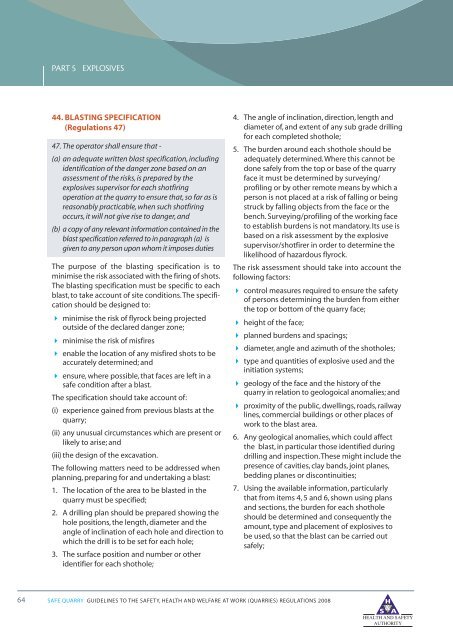Safe Quarry - Health and Safety Authority
Safe Quarry - Health and Safety Authority
Safe Quarry - Health and Safety Authority
You also want an ePaper? Increase the reach of your titles
YUMPU automatically turns print PDFs into web optimized ePapers that Google loves.
PART 5<br />
EXPLOSIVES<br />
44. BLASTING SPECIFICATION<br />
(Regulations 47)<br />
47. The operator shall ensure that -<br />
(a) an adequate written blast specification, including<br />
identification of the danger zone based on an<br />
assessment of the risks, is prepared by the<br />
explosives supervisor for each shotfiring<br />
operation at the quarry to ensure that, so far as is<br />
reasonably practicable, when such shotfiring<br />
occurs, it will not give rise to danger, <strong>and</strong><br />
(b) a copy of any relevant information contained in the<br />
blast specification referred to in paragraph (a) is<br />
given to any person upon whom it imposes duties<br />
The purpose of the blasting specification is to<br />
minimise the risk associated with the firing of shots.<br />
The blasting specification must be specific to each<br />
blast, to take account of site conditions.The specification<br />
should be designed to:<br />
minimise the risk of flyrock being projected<br />
outside of the declared danger zone;<br />
minimise the risk of misfires<br />
enable the location of any misfired shots to be<br />
accurately determined; <strong>and</strong><br />
ensure, where possible, that faces are left in a<br />
safe condition after a blast.<br />
The specification should take account of:<br />
(i) experience gained from previous blasts at the<br />
quarry;<br />
(ii) any unusual circumstances which are present or<br />
likely to arise; <strong>and</strong><br />
(iii) the design of the excavation.<br />
The following matters need to be addressed when<br />
planning, preparing for <strong>and</strong> undertaking a blast:<br />
1. The location of the area to be blasted in the<br />
quarry must be specified;<br />
2. A drilling plan should be prepared showing the<br />
hole positions, the length, diameter <strong>and</strong> the<br />
angle of inclination of each hole <strong>and</strong> direction to<br />
which the drill is to be set for each hole;<br />
3. The surface position <strong>and</strong> number or other<br />
identifier for each shothole;<br />
4. The angle of inclination, direction, length <strong>and</strong><br />
diameter of, <strong>and</strong> extent of any sub grade drilling<br />
for each completed shothole;<br />
5. The burden around each shothole should be<br />
adequately determined.Where this cannot be<br />
done safely from the top or base of the quarry<br />
face it must be determined by surveying/<br />
profiling or by other remote means by which a<br />
person is not placed at a risk of falling or being<br />
struck by falling objects from the face or the<br />
bench. Surveying/profiling of the working face<br />
to establish burdens is not m<strong>and</strong>atory. Its use is<br />
based on a risk assessment by the explosive<br />
supervisor/shotfirer in order to determine the<br />
likelihood of hazardous flyrock.<br />
The risk assessment should take into account the<br />
following factors:<br />
control measures required to ensure the safety<br />
of persons determining the burden from either<br />
the top or bottom of the quarry face;<br />
height of the face;<br />
planned burdens <strong>and</strong> spacings;<br />
diameter, angle <strong>and</strong> azimuth of the shotholes;<br />
type <strong>and</strong> quantities of explosive used <strong>and</strong> the<br />
initiation systems;<br />
geology of the face <strong>and</strong> the history of the<br />
quarry in relation to geologoical anomalies; <strong>and</strong><br />
proximity of the public, dwellings, roads, railway<br />
lines, commercial buildings or other places of<br />
work to the blast area.<br />
6. Any geological anomalies, which could affect<br />
the blast, in particular those identified during<br />
drilling <strong>and</strong> inspection.These might include the<br />
presence of cavities, clay b<strong>and</strong>s, joint planes,<br />
bedding planes or discontinuities;<br />
7. Using the available information, particularly<br />
that from items 4, 5 <strong>and</strong> 6, shown using plans<br />
<strong>and</strong> sections, the burden for each shothole<br />
should be determined <strong>and</strong> consequently the<br />
amount, type <strong>and</strong> placement of explosives to<br />
be used, so that the blast can be carried out<br />
safely;<br />
64<br />
SAFE QUARRY GUIDELINES TO THE SAFETY, HEALTH AND WELFARE AT WORK (QUARRIES) REGULATIONS 2008
















